Are you ready to embark on a unique and sustainable housing project of building your shipping container home in New Hampshire? Look no further! Constructing an intermodal shipping container home in NH offers an exciting opportunity to create a one-of-a-kind living space that is both economical and eco-friendly.
Utilizing shipping containers as a foundation for home construction has gained tremendous popularity in recent years, and for good reason. Not only are shipping containers readily available, but they also offer numerous benefits in terms of durability, affordability, and versatility.
New Hampshire, known for its picturesque landscapes and a thriving architectural scene, presents itself as an ideal location for building shipping container homes.
With an abundance of beautiful natural settings, ample space, and a supportive community that appreciates innovative housing solutions, New Hampshire truly embraces the concept of sustainable living.
Table of Contents
Understanding Shipping Containers
A. Overview of Shipping Containers
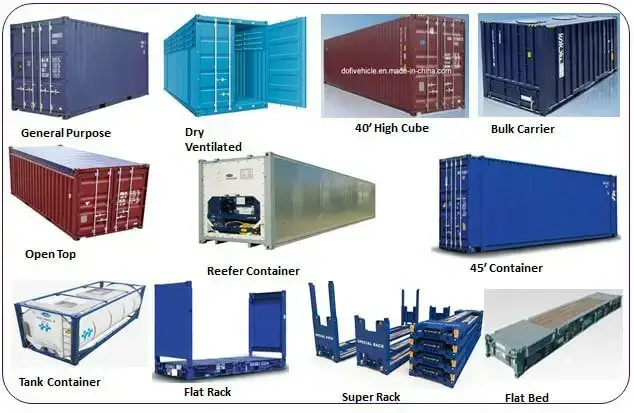
Shipping containers are large, metal rectangular containers that are primarily used for transporting cargo across long distances. These containers are designed to withstand the harsh conditions at sea, making them highly durable and weather-resistant.
- Types and sizes of shipping containers commonly used for construction:
As shown in the picture above, there are several types and sizes of shipping containers that can be repurposed for building homes. Some of the commonly used ones are:
- Standard containers (20 and 40 feet in length)
- High cube containers (providing extra vertical space)
- Open-top containers (with removable roof for easy loading)
- Flat rack containers (for transporting oversized cargo)
- Refrigerated containers (for temperature-controlled storage)
- Structural features and considerations:
Shipping containers are made from Corten steel, which is highly resistant to corrosion. They have a rigid and sturdy structure, with reinforced corners and vertical beams to ensure structural integrity. It is important to consider these features when planning the construction of a shipping container home.
Read More on Shipping Container Home VS Prefab Home: Do the Right Thing
B. Advantages of Using Shipping Containers for Building Homes in New Hampshire
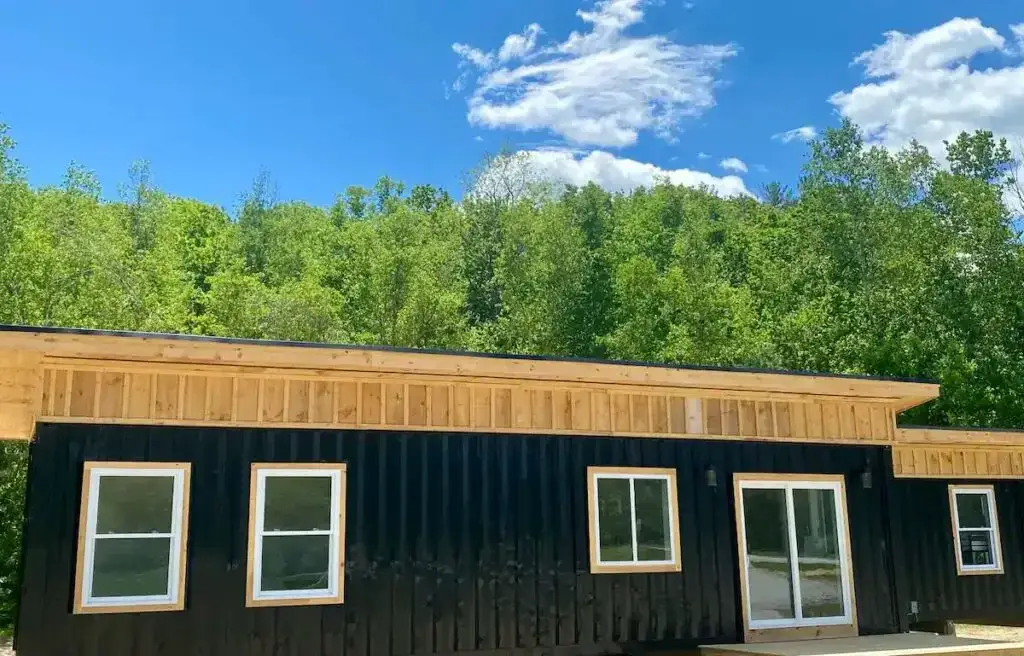
- Durability and strength:
Shipping containers are built to withstand extreme weather conditions, making them highly durable and long-lasting. They can resist earthquakes, hurricanes, and other natural disasters.
- Cost-effectiveness compared to traditional construction methods:
Using shipping containers for building homes can be more cost-effective compared to traditional construction methods. The containers can be purchased at a relatively lower cost, and the construction process is often quicker and more efficient.
- Customizability and modular nature:
Shipping containers can be easily modified and customized to fit specific design requirements. They can be stacked or combined to create larger living spaces and can be easily transported to different locations if needed.
Finding Reliable Builders for Your Container Home in New Hampshire
A. Researching local builders experienced in shipping container home construction:
- Look for builders in New Hampshire who specialize in shipping container home construction.
- Check their websites, social media profiles, and online reviews to gather information about their expertise and reputation.
- Consider reaching out to local community forums, online groups, or networking events to get recommendations from others who have built shipping container homes in New Hampshire.
B. Reviewing their portfolios and previous work:
- Study the portfolio of each builder to assess the quality of their work and their ability to meet your design and construction requirements.
- Look for builders who have successfully completed similar projects in the past.
- Pay attention to the aesthetics, functionality, and innovation showcased in their previous work.
C. Requesting references and client testimonials:
- Ask each builder for references from previous clients who have had shipping container homes constructed by them.
- Contact these references and ask about their experience working with the builder, the quality of the construction, and their overall satisfaction.
- Read client testimonials on the builder’s website or other online platforms to get a better understanding of their reputation.
D. Scheduling site visits to view their ongoing or completed projects:
- Arrange site visits to ongoing or completed projects of the builders you are considering.
- Observe the construction techniques, materials used, and overall craftsmanship.
- Talk to the builders and their clients during these visits to get a firsthand perspective on their professionalism, communication skills, and attention to detail.
Read More on Shipping Container Home in NSW: A Cost-Effective Living
Navigating Permit and Building Regulations in New Hampshire
A. Overview of Building Codes and Regulations Specific to New Hampshire
Before embarking on your shipping container home project in New Hampshire, it is crucial to familiarize yourself with the building codes and regulations that apply to your area. Each state, including New Hampshire, has its own set of regulations that govern construction projects, ensuring safety and compliance.
B. Understanding Permit Requirements for Shipping Container Homes
Building a shipping container home in New Hampshire requires obtaining the necessary permits and approvals. These permits may include but are not limited to:
- Building permit: This permit is necessary to ensure that your shipping container home meets the requirements of local building codes and regulations.
- Zoning permit: Depending on the location of your property, a zoning permit may be required to ensure your shipping container home complies with the specific zoning ordinances of the area.
- Septic system permit: If your shipping container home will have its own septic system, you will need to obtain a permit to install and operate it properly.
- Electrical permit: If you plan to install or modify the electrical systems within your shipping container home, an electrical permit may be required to ensure compliance with safety regulations.
- Plumbing permit: Similarly, if you are installing or modifying the plumbing systems within your shipping container home, a plumbing permit may be necessary.
- Completely revised 9th Edition of Code Check.
- Easy-to-use guide to building codes for a safe and sound home.
- Shows you how to build a safe, sound house without a professional inspector.
- Incorporates the most current building codes from the International Residential Code (IRC).
- Provides hundreds of illustrations in full-color.
- Details the correct installation of critical items.
- Answers common building code questions from today’s do-it-yourselfer.
C. Consulting with Local Authorities and Building Inspectors for Compliance
Consulting with local authorities and building inspectors is essential to ensure compliance with the building codes and regulations specific to your area in New Hampshire. They can provide valuable insights, guidance, and information on the specific requirements you need to meet when building a shipping container home.
D. Tips for Successfully Obtaining Necessary Permits and Approvals
Obtaining the necessary permits and approvals for your shipping container home project can be a complex process. Here are some tips to ensure a smoother experience:
- Do thorough research: Familiarize yourself with the building codes and regulations specific to your area in New Hampshire.
- Engage professionals: Seek the assistance of architects, designers, or contractors experienced in shipping container home construction to guide you through the permit application process.
- Prepare comprehensive plans: Create detailed plans and blueprints of your shipping container home, highlighting compliance with building codes and regulations.
- Communicate with local authorities: Maintain a transparent and open line of communication with local authorities and building inspectors throughout the permit application process.
- Follow instructions carefully: Ensure all necessary documents, forms, and fees are submitted correctly and in a timely manner.
- Address concerns promptly: If any concerns or objections are raised during the permit application process, address them promptly to avoid unnecessary delays.
Read More on How to Build A Storm Shelter Out Of A Shipping Container
Cost Estimates and Budgeting

A. Factors Influencing the Cost of Building a Shipping Container Home
Building a shipping container home in New Hampshire requires considering various factors that can influence the overall cost. Some of the key factors are:
- Size and number of containers needed
- Foundation requirements
- Customization and architectural design
- Insulation and climate control
- Plumbing and electrical systems
- Permit and inspection fees
- Site preparation and land costs
B. Analyzing Cost Differences Between Traditional Construction and Container Homes
Comparing the cost of building a shipping container home with traditional construction methods is essential for budgeting purposes.
While the initial cost of containers may be lower, additional expenses like customization, insulation, and foundation can offset the savings. However, container homes usually require less labor and construction time, resulting in overall savings.
C. Gathering Accurate Cost Estimates From Builders and Suppliers
To ensure accurate budgeting, it is crucial to gather detailed cost estimates from reliable builders and suppliers in New Hampshire. Talk about your specific requirements, customization options, and any potential additional charges.
Requesting itemized quotes will help you understand the breakdown of costs for materials, labor, permits, and other necessary expenses.
Read More on Shipping Container Home in Kansas City: Modern Housing Solution
D. Strategies for Budgeting and Managing Costs Effectively
Managing costs effectively during the construction of a shipping container home can be achieved through the following strategies:
- Create a detailed budget plan, including all anticipated expenses
- Consider DIY options for certain aspects if you have the required skills
- Compare prices from different suppliers and contractors
- Prioritize essential features and modifications
- Plan for potential contingency funds
- Regularly communicate with builders to stay updated on cost progress
- Monitor expenses closely and make adjustments if necessary
Design and Architecture of Shipping Container Homes

When it comes to building a shipping container home, the design and architecture play a crucial role in creating a unique and functional living space.
Shipping containers offer endless creative possibilities that can be transformed into stunning homes. In this section, we will explore the different aspects of design and architecture in shipping container homes.
A. Creative Design Possibilities with Shipping Containers
Shipping containers allow for tremendous flexibility in design, allowing homeowners to unleash their creativity and create truly one-of-a-kind homes.
From single-story structures to multi-level designs, the possibilities are endless. The modular nature of shipping containers also makes it easy to expand or modify the structure as needed.
Read More on Shipping Container Home Companies: Expert Guide
B. Exploring Various Architectural Styles and Design Inspirations
Shipping container homes can be designed to match various architectural styles, ranging from modern and minimalist to rustic and industrial.
By incorporating different materials, colors, and finishes, you can achieve the desired aesthetic and create a home that reflects your personal style.
C. How to Adapt Container Structures to Suit Different Home Designs
Adapting container structures to suit different home designs requires careful planning and consideration. Professional builders in New Hampshire have the expertise to modify shipping containers to fit seamlessly into existing architectural plans.
Whether you’re looking to build a small vacation home or a spacious family residence, container structures can be customized to meet your specific design requirements.
Read More on Building a Container Home in Colorado: Unique Housing Solution
D. Interior and Exterior Design Considerations for Container Homes
Designing the interior and exterior of a shipping container home requires thoughtful consideration. Key factors to take into account include optimizing natural light, utilizing efficient storage solutions, and creating comfortable living spaces.
Exterior design aspects such as window placement, siding materials, and landscaping also contribute to the overall aesthetic appeal of container homes.
Sustainability and Eco-Friendly Options
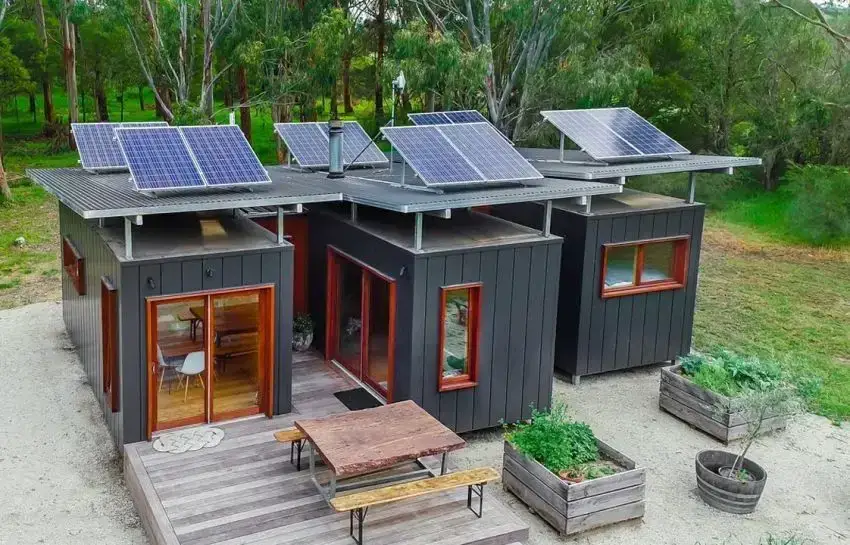
Building a shipping container home in New Hampshire offers numerous advantages when it comes to sustainability and eco-friendly options. Not only do these homes provide a unique and modern living space, but they also contribute to a greener future.
Advantages of Sustainable Building Practices in Container Homes in New Hampshire
Shipping container homes inherently embrace sustainable building practices. By repurposing used shipping containers, we reduce waste and minimize the carbon footprint associated with traditional construction methods. This eco-friendly approach helps combat climate change and promotes a circular economy.
Incorporating Eco-friendly Materials and Efficient Systems
When building a shipping container home in New Hampshire, there are various eco-friendly materials and efficient systems you can incorporate. From recycled insulation materials to energy-efficient windows and appliances, each choice contributes to a more sustainable living space.
Read More on Building A Container Home In Massachusetts: A Modern Solution
Green Energy Options for Heating, Cooling, and Electricity
In addition to using eco-friendly materials, you have the opportunity to explore green energy options for heating, cooling, and electricity in your shipping container home.
Solar panels, geothermal heating, and energy-efficient HVAC systems are just a few examples of the sustainable solutions available.
Read More on The Environmental Benefits of Shipping Container Homes
Tips for Minimizing the Environmental Impact During Construction
During the construction phase, there are several ways to minimize the environmental impact. Utilizing low-VOC paints and sealants, implementing proper waste management practices, and sourcing locally-produced materials all help reduce carbon emissions and support the local economy.
By considering sustainability and eco-friendly options throughout the process of building your shipping container home in New Hampshire, you can create a dwelling that aligns with your values and contributes to a more environmentally conscious lifestyle.
Insulation and Climate Considerations

A well-insulated shipping container home is essential for maintaining a comfortable indoor climate throughout the year. New Hampshire’s climate, with cold winters and hot summers, requires careful consideration when choosing insulation materials.
Understanding the Importance of Insulation and Climate Control in Container Homes
Types of Insulation Suitable for New Hampshire’s Climate
New Hampshire’s climate demands insulation materials that can withstand cold winters and varying temperatures. Some suitable options include:
- Fiberglass insulation: A common and cost-effective choice, fiberglass insulation is available in various thicknesses. It offers excellent thermal resistance and is resistant to moisture.
- Spray foam insulation: This type of insulation provides a superior air seal and is highly effective in reducing drafts and heat loss. It expands to fill gaps and can adhere to irregular surfaces, ensuring maximum insulation.
- Cellulose insulation: Made from recycled paper or plant fibers, cellulose insulation is an eco-friendly option. It has good thermal properties and is resistant to mold, pests, and fire.
Read More on Easy Explanation To What Is A Plumbing Process
| Image | Product Title | Features | Price |
|---|---|---|---|
 | Buy on Amazon | ||
 | Buy on Amazon | ||
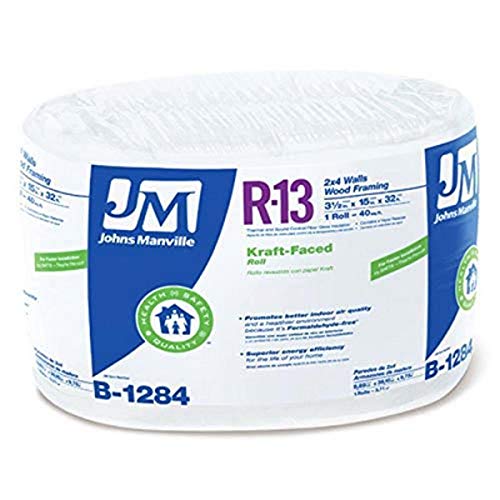 | Buy on Amazon |
HVAC Systems and Ventilation Solutions for Container Homes
Insulation plays a crucial role in container homes, as metal containers are not naturally insulated. Without proper insulation, these homes can become unbearably hot during summer months and freezing cold during winter. Insulation helps to maintain a consistent temperature and reduce energy consumption for heating or cooling.
In addition to insulation, proper ventilation and HVAC systems are crucial for maintaining a comfortable indoor environment. Adequate ventilation helps to regulate moisture levels, prevent condensation, and improve air quality. Some ventilation solutions to consider include:
- Natural ventilation: Utilize windows and vents strategically to allow for cross-ventilation and fresh air circulation.
- Mechanical ventilation: Install exhaust fans and intake vents to efficiently remove stale air and bring in fresh air.
- Heat recovery ventilation (HRV) systems: HRV systems recover heat from outgoing air and transfer it to incoming fresh air, reducing energy loss while providing ventilation.
Potential Challenges Related to Temperature Control
Container homes may face challenges in temperature control due to the thermal properties of steel and the potential for air leaks. To address these challenges:
- Ensure proper sealing: Seal any gaps or openings in the container walls to prevent air leaks and heat transfer.
- Utilize reflective coatings: Applying reflective coatings to the exterior of the container can help to reduce heat absorption from the sun.
- Consider additional insulation layers: Adding an extra layer of insulation, such as rigid foam panels, can further improve the thermal performance of the container.
By carefully considering insulation materials, ventilation options, and addressing potential challenges, you can create a shipping container home in New Hampshire that offers optimal comfort and energy efficiency regardless of the season.
Read More on How Much Is A Container Home in Florida? Your Ultimate Guide
Plumbing and Electrical Systems
A. Special Considerations for Installing Plumbing in Container Homes
Building a shipping container home in New Hampshire requires special considerations when it comes to installing plumbing systems. Due to the limited space and unique structure of containers, it is crucial to plan and design the plumbing layout carefully.
- Ensure proper insulation and protection to prevent frozen pipes during the cold winter months.
- Consider the location and access to water sources, drainage systems, and sewage connections.
- Utilize compact and efficient fixtures to maximize the use of available space.
B. Electrical Requirements and Safety Considerations
When it comes to electrical systems in a shipping container home, it is essential to prioritize safety and compliance with local building codes. Here are some key considerations:
- Consult with a licensed electrician to determine the appropriate electrical load and capacity for your container home.
- Ensure proper grounding and insulation to minimize the risk of electrical hazards.
- Install adequate lighting fixtures and outlets to meet your power needs.
C. Engaging Professionals for Plumbing and Electrical Work
Given the technical complexity and potential risks involved, it is highly recommended to engage professionals for the installation of plumbing and electrical systems in your shipping container home.
- Hire experienced plumbers and electricians who are familiar with working on container homes.
- Request references and review their previous work to ensure their expertise and reliability.
- Obtain multiple quotes to compare prices and services before making a decision.
D. Tips for Efficient Use of Space and Optimizing Utility Solutions
When planning your plumbing and electrical systems, consider these tips to optimize space and utility solutions:
- Utilize vertical space by installing wall-mounted fixtures and storage solutions.
- Consider space-saving alternatives such as tankless water heaters or composting toilets.
- Incorporate smart home technology to automate and control your utility systems efficiently.
Read More on 15 Best Container Homes You Can Own Under $100K
Interior Design and Space Optimization
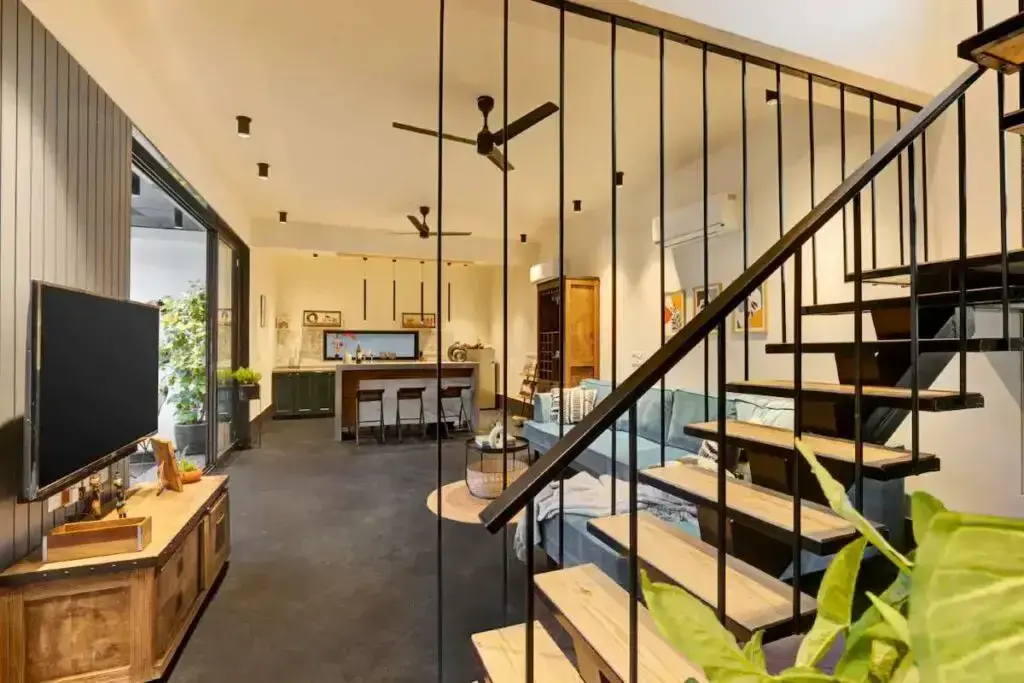
A well-designed shipping container home not only maximizes space but also creates a comfortable and visually appealing living environment. Here are some key considerations for interior design and space optimization:
Maximizing Space in a Container Home through Intelligent Design
With limited square footage, every inch counts in a shipping container home. Clever design techniques can help you make the most of the available space. Consider using:
- Multi-functional furniture: Opt for pieces that can serve multiple purposes, such as beds with built-in storage or convertible tables.
- Vertical storage: Utilize vertical space by installing shelves, cabinets, or hooks on the walls.
- Open floor plan: Keep the layout open and minimize partitions to create the illusion of more space.
Tips for Storage Solutions and Optimizing Layout
Effective storage solutions are crucial for keeping a container home organized and clutter-free. Try these tips:
- Utilize under-bed storage: Invest in beds with built-in drawers or use plastic containers under the bed to store items.
- Install wall-mounted shelves: Use wall space for storing books, decorative items, or kitchen essentials.
- Get creative with vertical storage: Hang pots and pans, use pegboards for tools, or utilize a wall-mounted shoe organizer.
Furniture and Decor Options Specifically Tailored for Container Homes
When selecting furniture and décor for your container home, consider these options:
- Sleek and compact furniture: Choose furniture with a smaller footprint to optimize space.
- Multipurpose pieces: Look for furniture that serves multiple functions, such as nesting tables or storage ottomans.
- Modular furniture: Invest in customizable and flexible furniture that can adapt to the changing needs of your home.
Balancing Aesthetics and Functionality in Container Home Interiors
Creating a visually appealing interior while maintaining functionality is essential. Here’s how to strike the right balance:
- Choose a cohesive color palette: Use a limited color scheme to create a harmonious and visually pleasing atmosphere.
- Opt for natural light: Incorporate windows, skylights, or glass doors to maximize natural light and make the space feel larger.
- Embrace minimalism: Keep décor and furnishings to a minimum, focusing on clean lines and simple yet impactful design elements.
- Consider versatile materials: Select materials that are durable, easy to clean, and can withstand the unique challenges of a container home.
Read More on 20 Best Interior Design Ideas For Beautiful Shipping Container Homes
Conclusion
Building a Shipping Container Home in New Hampshire offers unique opportunities that combine sustainability, affordability, and modern design. Throughout this guide, we have discussed various aspects of container home construction in the state.
- We started by understanding the basics of shipping containers and their potential for transforming into homes.
- We then explored how to find reliable builders in New Hampshire who specialize in container home construction.
- Next, we delved into the permits and building regulations required for this type of construction in the state.
- Cost estimates and budgeting considerations were thoroughly discussed to help you plan your project efficiently.
- We also highlighted the importance of design and architecture in creating aesthetically pleasing container homes.
- Identifying sustainable and eco-friendly options was another key focus, showcasing the environmental benefits of container homes.
- We addressed insulation and climate considerations to ensure comfortable living conditions year-round.
- Plumbing and electrical systems were explored, emphasizing the importance of professional installations.
- The interior design and space optimization aspect touched upon creative solutions to maximize the functionality of your container home.
As you embark on your container home journey, we encourage you to explore the unique opportunities offered in New Hampshire. The state’s beautiful landscapes, thriving communities, and commitment to sustainability make it an ideal location for container home enthusiasts.
If you need further assistance or have any inquiries about container home construction in New Hampshire, please feel free to reach out to us at [email protected] or call us at (254) 797-787-641. Our expert team is ready to help you turn your container home dreams into a reality.
Read More on How To Build A Container Home Step-by-Step For Beginners And Starters


